
The effect of colonisation on Africa’s modernisation is a highly contentious and emotional debate. The reality is trickier than you think.
Views on Africa’s prospects have always been polarising. The euphoria of the 1960s, when Africa turned independent, was followed by two chaotic decades when things fell apart (Bates 1983). As of 1999, Africa was the “Hopeless Continent”. However, after a decade of robust growth, partly stemming from the commodity super-cycle, the narrative changed; by 2011 Africa was the “Hopeful Continent”. Academic research has followed a similar dynamic. Between the 1970s and the 1990s, there were only a handful of papers on African development published outside specialised outlets. However, since the mid-2000s a vibrant literature on African political economy has come to life.
In a recent paper (Michalopoulos and Papaioannou, forthcoming), we review the recent wave of studies that connect contemporary African development to its past.1 Compared to earlier works, there are many differences. First, after realising that unfortunate post-independence policies, authoritarianism, conflict, and corruption (the focus of pre-2000 studies) have deep roots, recent research has opened the black box of Africa's history. Second, the new research agenda is interdisciplinary, with economists empirically scrutinising conjectures put forward by historians and political scientists. Third, a genuine effort to advance on causation is under way, often leveraging data including satellite imagery on land use and luminosity.
Our review covers research focusing on various aspects of: (i) the colonial era (c.1860-1960); (ii) the Scramble for Africa (1850-1900); (iii) the African slave trade (1500-1850); and (iv) pre-colonial ethnic-specific features, related among others, to political centralisation, social structure, and the type of subsistence economy.
Colonisation’s legacy
There is a fierce polemic on whether colonisation benefitted or hindered Africa's modernisation trajectory. Many view colonialism as responsible for almost all of Africa's current evils.2 Other scholars and policymakers argue, however, that colonisation was at least partly beneficial, pointing to transportation investments, the development of state institutions in places lacking political organisation, building of schools, and the eventual abolition of slavery. This debate is emotional. It is exemplified by the contentious fate of two statues of Cecil Rhodes, who more than anyone else symbolised African colonisation. Despite demonstrations, the statue of Rhodes remained in the main entrance to Oriel College in Oxford, but one was removed from the University of Cape Town.
Figure 1a Cecil Rhodes statue at Oriel College, University of Oxford
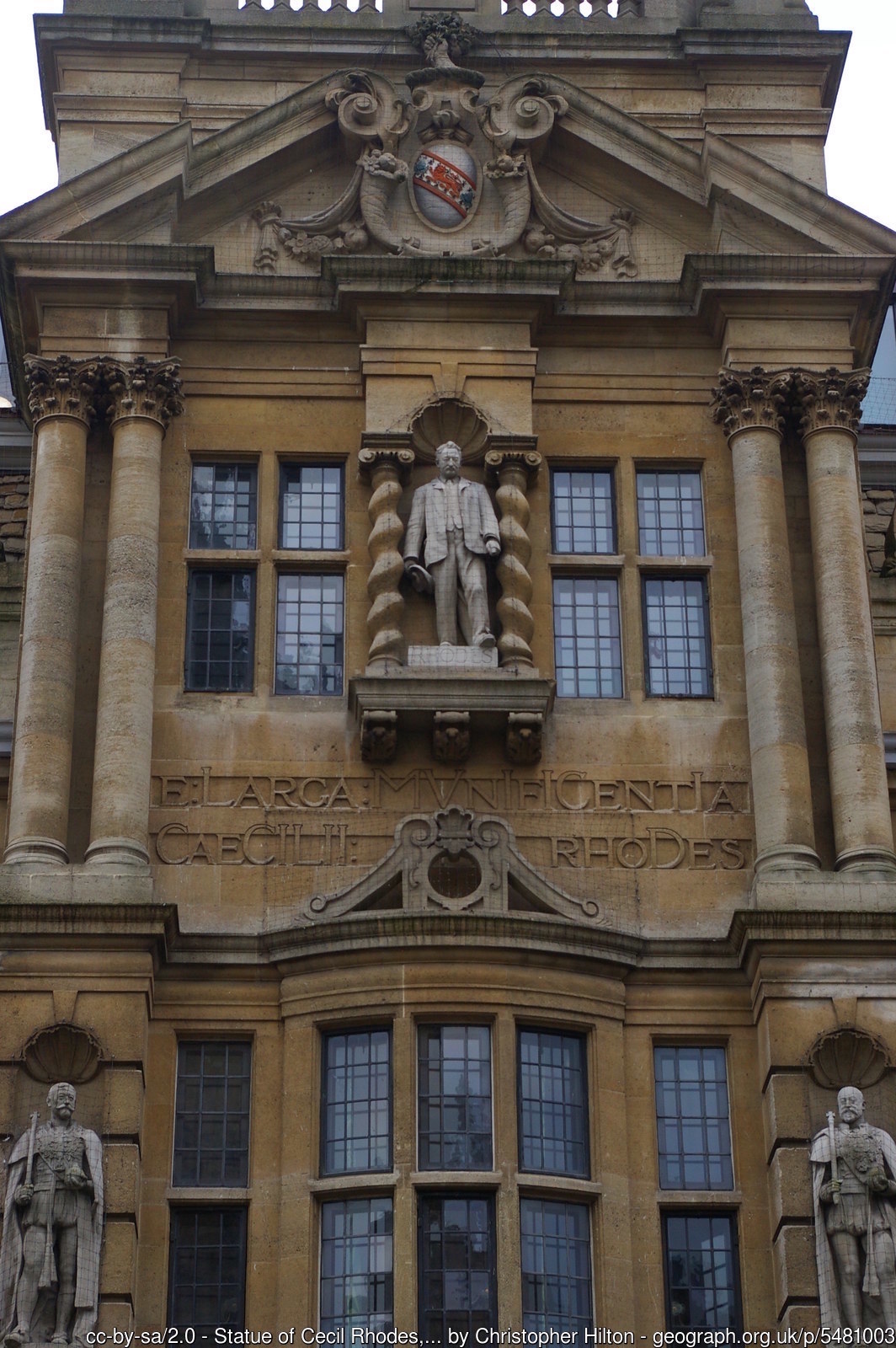
Figure 1b Cecil Rhodes statue at Cape Town University
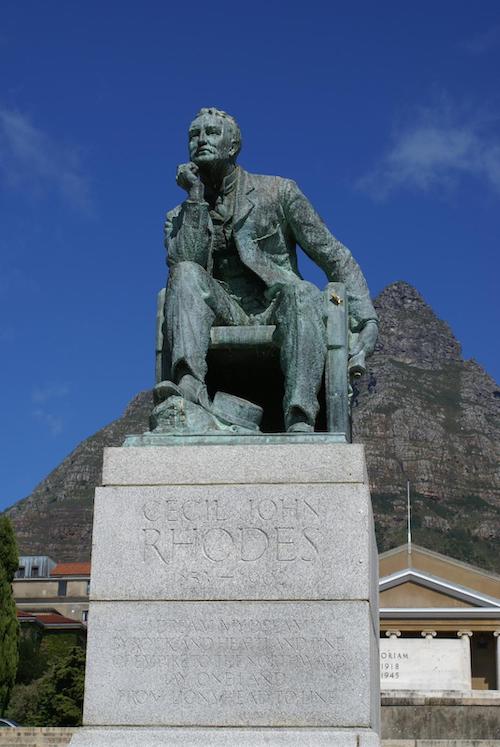
Addressing this debate is challenging, as it requires concrete answers as to how African economies, societies, and institutions would have evolved in the absence of colonialism that had both extractive and developmental elements. Although economists make a living by talking intelligently about counterfactuals, the literature has not moved in this direction. Instead, studies have largely abstracted from this macro debate and quantify the impact of specific aspects of colonisation, applying credible, albeit mostly ‘local’, identification designs.
Colonial institutions
Under widespread indirect rule, Europeans employed a variety of extractive policies and institutions, forced-labour systems, extortion-level taxation on farmers, oppression, and mass killings. Empirical studies document large adverse effects of all types of extractive colonial institutions, supporting the influential cross-country works of Acemoglu et al. (2001, 2002). The most notorious case of extraction was arguably King Leopold II's rule of the Congo Free State, which was his private estate for more than a decade (1895-1908). Lowes and Montero (2018) study the legacy of concessions in Congo, comparing development at the historical border. Living conditions, literacy, schooling, health, and height appear significantly lower inside the historical concessionary boundaries. Chiefs' are more authoritarian and less likely to be elected by the community, and public goods provision is worse inside the concession borders. These findings corroborate Mamdani’s (1996) influential conjecture that colonisation had lasting detrimental consequences by empowering unaccountable chiefs who held onto power after independence.
The most compelling evidence on persistence of local power comes from Acemoglu et al. (2014), who study native rule in Sierra Leone. They construct a remarkable dataset coding all chiefs that the British appointed from 1896 to 1903 and their descendants over the next century. Paramount chiefs, subordinate chiefs, and headmen ruled Sierra Leone's interior throughout the colonial era, relying on violence and oppression, and were accountable solely to the colonial administration in Freetown. The chiefs' power endured and even strengthened after independence, due to the country's weak state capacity to broadcast power outside the capital and a lasting civil conflict. Throughout post-independence, chiefs controlled land, settled disputes, taxed production, provided some public goods, and allocated votes to their preferred candidates in national elections.3
Colonial missionary activity
During colonisation, thousands of inspired Europeans, teachers, nurses, doctors, and students travelled to Africa to help communities overcome the legacy of enslavement and oppression. Sir Thomas Fowell Buxton's The African Slave Trade and its Remedy, published in 1839, popularised the ideology that promoting commerce, education, and Christianity would enable development. Protestant and Catholic missionaries built schools and clinics, encouraged by a colonial administration that wanted to minimise its costs and duties.
The literature assesses the role of various aspects of colonial educational policies on contemporary development either taking a pan-(sub-Saharan) African approach or focusing on particular colonies. Most studies document positive long-run correlations between missionary colonial schools and contemporary education, a pattern that is especially strong for Protestant missions (e.g. Nunn 2014). Cage and Rueda (2016) show that readership of newspapers, trust, and civic engagement are higher in areas close to missions with a printing press during colonisation. Fenske (2015) further shows that polygyny is lower close to Christian mission areas. Huillery (2009) documents higher educational attainment rates in districts in which the French West African administration built more schools, while Fourie and Swanepoel (2015) show strong inertia in the relationship between missionary schools and contemporary education in South Africa. In an important case study, Wantchekon et al. (2015) study educational persistence in Benin. Exploiting as-if-random assignment of early Christian schools across nearby villages, they uncover strong inertia and sizable local externalities. They also document considerably higher levels of upward mobility in villages with colonial schools, a pattern that seems to apply more generally across the continent (Alesina et al. 2019).
These correlations are consistent with the idea that colonisation’s impact on long-run development also operates via human capital, a point emphasised by Glaeser et al. (2004). However, causality is still an open issue. The location of Christian missions and colonial schools is not random – it relates to the disease environment (malaria and yellow fever), local topography, and the preceding slave trades (Jedwab et al. 2018).
Colonial infrastructure investments
During African colonisation, scholars and policymakers viewed investments in transportation as a potentially major positive influence. Both Lenin and Rhodes believed that railroad and road investments would transform the continent. Recent work by Jedwab and Moradi (2016) and Kerby et al. (2017) provides support to this idea. Looking across 44 countries and zooming into Ghana and Kenya, they show that local development is higher in areas close to colonial railroads. The problem for Africa has been the very limited colonial railroad (and road) investments. Figure 2 illustrates this in Mozambique. In a colony larger than France, there were just three main and two subordinate rail lines that connected the ports of Lourenço Marques, Beira, and Nacala to the interior. The objective was to ship minerals and agricultural goods to Europe and the Americas. There was no effort whatsoever to connect the Southern with the Central and Northern provinces. Mozambique was effectively split into three zones, and this tracheotomy is still present.
Figure 2 Colonial railroads in Mozambique
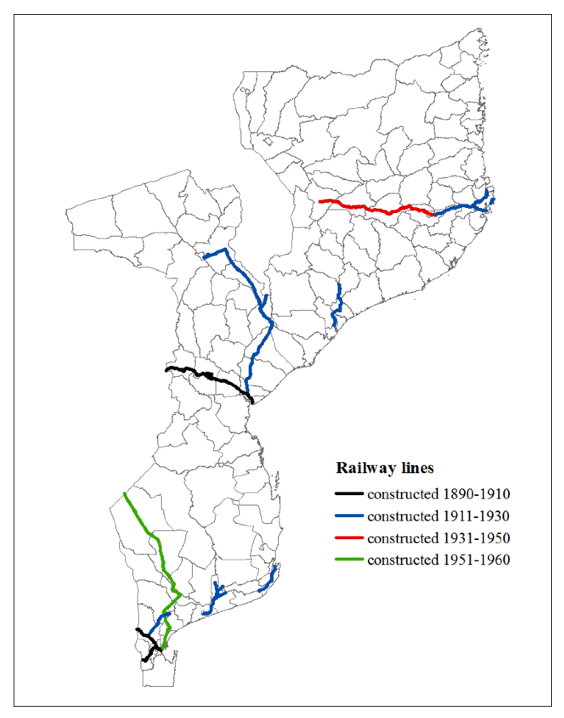
The Scramble for Africa
According to many, the most detrimental impact of Europe in Africa was not colonisation per se, but the artificial borders that colonisers designed when they partitioned the largely unexplored continent at the end of the 19th century (Herbst 2000). As the key consideration was to prevent Europeans from fighting on African soil and since no one could foresee African independence, colonisers drew borders without taking into account local geographic, cultural, and political conditions. British Prime Minister Lord Salisbury summarised the process:
“we have been engaged in drawing lines upon maps where no white man’s feet have ever trod; we have been giving away mountains and rivers and lakes to each other, only hindered by the small impediment that we never knew exactly where the mountains and rivers and lakes were”.
The colonial arrangements had little impact on the local populations initially, as Africans could move across the borders. Yet upon independence, the markings acquired salience. Henk Wesseling succinctly captured this moment:
"The partition of Africa was recorded by the Europeans on their maps, but the matter rested there for the time being.... In Europe conquests preceded the drawing of maps; in Africa the map was drawn, and then it was decided what was going to happen. These maps did not therefore reflect reality but helped to create it."
Recent research uncovers the lasting legacy of the Scramble for Africa. Its aftermath seems to operate via at least three channels. First, Africa is the continent with the largest share of landlocked countries. Niger, Chad, Burkina Faso, the Central African Republic, Rwanda, Burundi, and Uganda, among others, have suffered, as their ability to access world markets via global shipping routes depends on their war-prone and unstable neighbouring countries (Collier 2007, Storeygard 2016). Second, for many African states their sprawling size and their vast differences in geography, coupled with the limited infrastructure investments by the colonial administration, limited their ability to broadcast power beyond the capitals (Michalopoulos and Papaioannou 2014, Herbst 2000). Third, approximately a third of African ethnicities saw their ancestral homelands partitioned between different countries. The Diolas in the Casamance have been split between Senegal, Guinea, and Guinea-Bissau. The Togo-Ghana border partitions the Ewe and the Kenyan-Tanzania border splits the Maasai.
In Michalopoulos and Papaioannou (2016) we examine the consequences of ethnic partitioning on contemporary conflict combining anthropological maps on the spatial distribution of ethnicities during colonisation. This is highlighted in Figure 3a (from anthropologist George Peter Murdock) and Figure 3b, georeferenced data on violence from the Armed Conflict Location & Event Data project and other sources covering ethnic-based conflict.
Figure 3a Ethnic homelands (Murdock 1959) and national borders
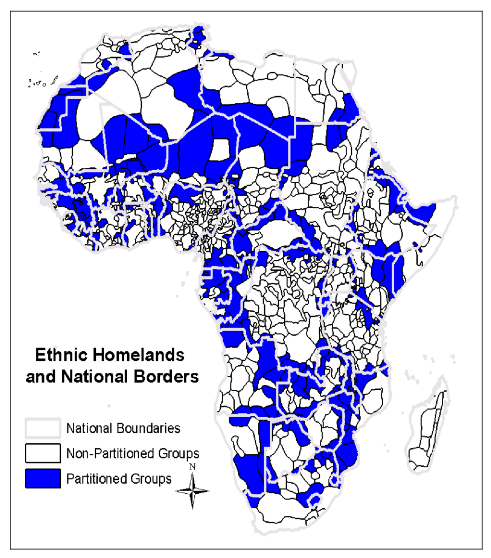
Figure 3b Violence in Africa, 1997-2010 (ACLED)
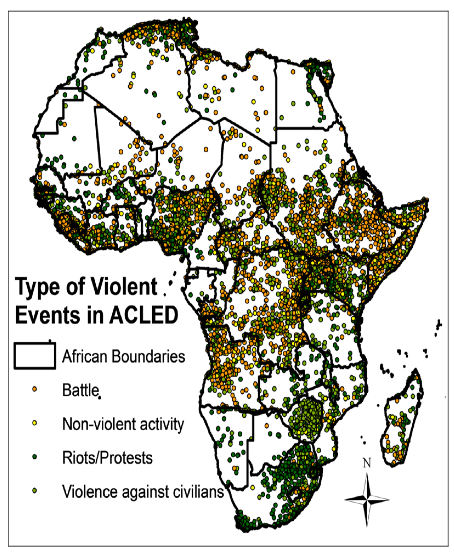
Ethnic partitioning has played a non-negligible role in spurring conflict and animosity in Africa:
- Homelands of partitioned ethnicities are disproportionately affected by conflict between state forces and rebels that have an explicit agenda to overthrow the government.
- Violence against civilians, including village or church burnings, child soldiering, kidnappings, and abductions relate to ethnic partitioning (Figure 4 summarises the results).
- Countries often use split groups to stage proxy wars in their neighbours.
- Partitioned ethnicities are more likely to engage in civil wars that have an explicit ethnic dimension. Since the early 1960s, roughly a third of split groups have participated in an ethnic-based civil war, while the share of non-split groups that have engaged in an ethnic war is around a fifth.
- The likelihood that split ethnicities face discrimination in the political sphere is 10 percentage points higher for split, as compared to non-split groups (25% compared to 15%).
- Survey data show that education and public goods provision is significantly lower for individuals of split ethnicities, even when compared to Africans from non-split groups in the same town/village.
These results are in line with anecdotal evidence and case studies, as well as cross-country studies uncovering positive associations between ethnic partitioning and border artificiality with underdevelopment and conflict (Alesina et al. 2012).
Figure 4 Ethnic partitioning and civil conflict
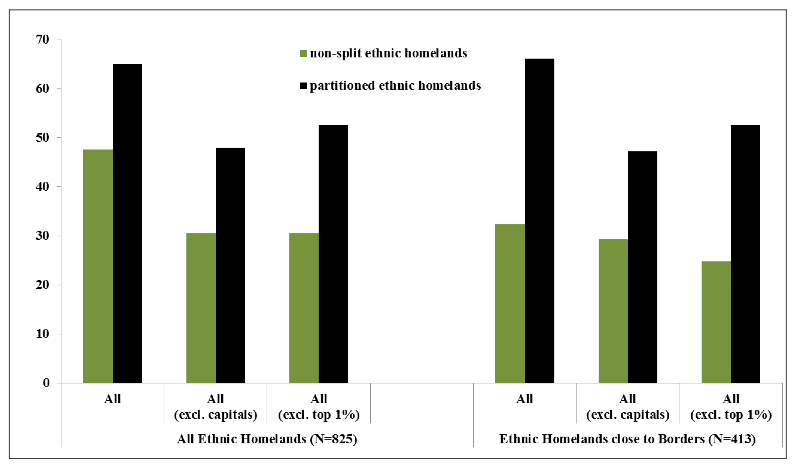
The legacy of Africa’s slave trades
Europeans’ contact with Africa predates colonisation. Between 1400 and 1900, Africa experienced four large slave trades. In the Transatlantic Slave Trade more than 12 million Africans, mostly from West Africa were enslaved and then shipped to the Americas. On top of this, approximately eight million Africans were enslaved during the East Africa, the Red Sea, and the trans-Saharan slave trades.
Figure 5a Slave exports by ethnicity
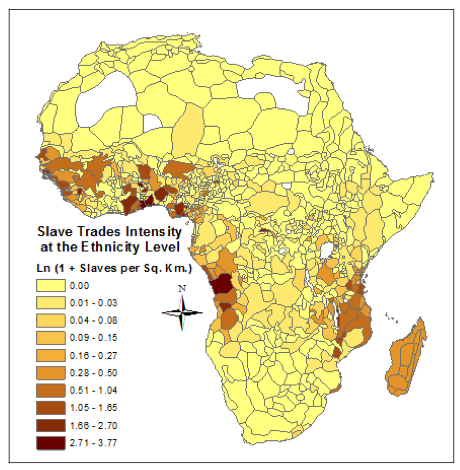
Figure 5b Slave exports by country

In influential work, Nunn (2008) uncovered a strong link between Africa's slave trades and contemporary development. Nunn merged shipment data on slaves’ ethnic affiliation (besides port) with Murdock’s map delineating African ethnic boundaries and then examined the association of economic well-being and slave trade intensity (Figures 5a and 5b). Figure 6 summarises his important result. Economic development, as reflected in the log of real GDP per capita is, on average, lower in countries whose populations were affected the most by the slave trades. This association remains robust to geographic and colonial controls. ‘Reverse causation’ concerns are muted, as the slave trades did not initially affect underdeveloped places; if anything, strong and more economically advanced African states with higher population densities suffered the most.
Figure 6 Log real GDP p.c. and slave exports (normalised by countries’ land areas)
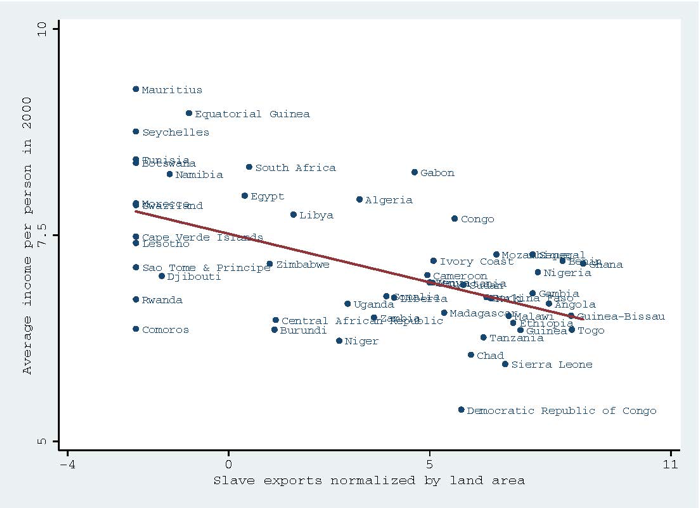
A series of follow-up research shed light on the mechanisms driving persistence:
- Nunn and Wantchekon (2011) show a link between enslavement and distrust.
- Slave exports altered the sex ratio, reinforcing the practice of polygyny that relates to the spread of HIV and under-investments in education (Teso 2017, Bertocchi and Dimico 2015)
- Educational attainment is lower among ethnic groups that were affected the most, an interesting pattern as often missionaries targeted the Slave Coast in their desire to ‘liberate’ Africans (Okoye and Pongou 2015).
- Slave exports in the 16th-19th century correlate with contemporary conflict (Fenske and Kala 2017, Boxell 2018) and authoritarianism (Whatley 2014).
- Recent studies show that slave exports can explain Africa’s low levels of financial development (Pierce and Snyder 2017, Levine et al. 2017).
Pre-colonial ethnic-specific features and contemporary development
There were large differences across ethnic groups on economic organisation, political institutions, and societal structure before colonisation. While our knowledge of pre-colonial Africa is still limited, a vibrant research in cultural anthropology is trying to document, map, and understand the origins of differences in lineage, statehood, polygyny, and practices of African ethnicities. Economists have utilised anthropological data and ethnographic maps, mostly Murdock’s map, to explore their role and their deep roots.
In Michalopoulos and Papaioannou (2013), we examine the role of pre-colonial political centralisation at the ethnic homeland level, blending information on ethnicities’ political organisation with satellite imagery on light density at night that approximates economic development at the regional level. Compared to societies lacking political hierarchy beyond the local level (such as the Nuer or the Tiv), economic development is higher in small and especially large-paramount chiefdoms (such as the Ashante). Regional development is the highest in the ancestral homelands of societies organised as states at the time of colonisation (for example, Zulus). These within-country associations, while not necessarily causal, are robust to the inclusion of various controls and even apply when we compare neighbouring ethnic homelands in the same country.
Michalopoulos et al. (2018) examine how pre-colonial subsistence patterns that differ substantially across groups influence one’s contemporary economic status. The authors show that the more one's ancestral group's relied on agriculture, the better one's economic outcomes are today. The authors provide provisional evidence that violence and impatience are higher among descendants of pastoralists.
Moscona et al. (2017, 2018) examine the legacy of kinship, which differed considerably across pre-colonial Africa. In segmentary lineage ethnicities, economic and social activities centre on the family and along patrilineal or matrilineal lineages (where groups usually identify with a mythical ancestor). In line with Robert Putnam's influential conjecture that strong family ties impede the development of general trust, they find a trust gap for individuals from segmentary lineage ethnicities. The authors further show that segmentary lineage societies experience more conflict today.
Moving forward
As always there are issues that future work is bound to address. To start with, we need better and more refined data on colonial institutions and investments in education, health, and infrastructure, ideally covering all of (sub-Saharan) Africa. Higher-quality data with a wider spatial coverage will not only allow us to improve our understanding quantitatively, but also explore heterogeneity. This heterogeneity is likely to be considerable, but hard to trace when focusing on specific case studies, irrespective of how well identified they are.
Another area where progress is needed is in studying how colonial and pre-colonial features shaped the political equilibrium at independence and the post-independence economic trajectories. Future research should examine in detail in which periods colonial and pre-colonial legacies become salient and explore heterogeneity over time. This is interesting as historical features may interact with policies and macroeconomic shocks.
A further avenue is to examine interconnections between the main shocks. For example the slave trades affected colonisation and pre-colonial ethnic institutions and vice versa (Whatley 2014). Finally, as the research on Africa's economic history and in development economics have blossomed in parallel, we believe that future work should break the ‘wall’ and examine the role of historical legacies on the success or failure of the various on-going policy interventions (as in Lowes and Montero 2018).
The exploration of these inquiries should not only come from ‘outsiders’, but also from African scholars. Research on African development entails a ‘neo-colonialist’ element, reflecting the views and biases of European and American (educated) scholars. The next review of the literature should come from African scholar(s) working in African universities.
References
Acemoglu, D, S Johnson and J Robinson (2001), “The colonial origins of comparative development: An empirical investigation”, American Economic Review 91(5): 1369-1401.
Acemoglu, D, S Johnson and J Robinson (2002), “Reversal of fortune: Geography and institutions in the making of the modern world income distribution”, Quarterly Journal of Economics 117(4): 1231-1294.
Acemoglu, D, T Reed and J Robinson (2014), “Chiefs: Economic development and elite control of civil society in Sierra Leone”, Journal of Political Economy, 122(2): 319-68.
Alesina, A, W Easterly and J Matuszeski, “Artificial states”, Journal of the European Economic Association, 9(2): 246-277.
Alesina, A, S Hohmann, S Michalopoulos and E Papaioannou (2019), “Intergenerational mobility in Africa”, CEPR Discussion Paper 13497.
Bates, R (2008), When things fell apart: State failure in late-century Africa, Cambridge University Press, New York, NY.
Bertocchi, G and A Dimico (2018), “The long-term determinants of female HIV infection in Africa: The slave trade, polygyny, and sexual behaviour,” working paper, University of Modena, Modena, IT.
Boxell, L (2018), “Droughts, conflict, and the African slave trade,” mimeo, Stanford University, Economics Department.
Cagé, J and V Rueda (2016), “The long-term effects of the printing press in sub-Saharan Africa”, American Economic Journal: Applied Economics 8(3): 69-99.
Cagé, J and V Rueda (2018), “Sex and the mission: The conflicting effects of early Christian investments on sub-Saharan Africa's HIV epidemic,” Working Paper, Paris School of Economics.
Collier, P (2007), The bottom billion: Why the poorest countries are failing and what can be done about it, Oxford: Oxford University Press.
Fenske, J (2015), “African polygamy: Past and Present,” Journal of Development Economics 117(2): 58-73.
Fenske, J and N Kala (2015), “Climate and the slave trade”, Journal of Development Economics 112(1): 19-32.
Fourie, J and C Swanepoel (2015), “When selection trumps persistence: The lasting effect of missionary education in South Africa,” Tijdschrift voor Sociale en Economische Geschiedenis 12(1):1-29.
Glaeser, E, R La Porta, F Lopez-de-Silanes and A Shleifer (2004), "Do institutions cause growth?", Journal of Economic Growth 9(3): 271-303.
Herbst, J (2000), States and power in Africa, Princeton University Press, Princeton, NJ.
Huillery, E (2009), “History matters: The long-term impact of colonial public investments in French West Africa,” American Economic Journal: Applied Economics 1(2), 176-215.
Kerby, J and A Moradi (2017), “History, path dependence and development: Evidence from colonial railroads, settlers and cities in Kenya,” Economic Journal, 127(603), 1217-1729.
Levine, R, C Lin and W Xie (2018), “The origins of financial development: How the African slave trade continues to influence modern finance”, NBER Working Paper.
Jedwab, R and A Moradi (2016), “The permanent effects of transportation revolutions in poor countries: Evidence from Africa”, Review of Economics and Statistics, forthcoming.
La Porta, R, F Lopez-de-Silanes and A Shleifer (2008), “The Economic consequences of legal origins”, Journal of Economic Literature 46(2): 285-332.
Logan, C (2011), “The roots of resilience: Exploring popular support for African traditional authorities,” Afrobarometer Working Paper No. 128.
Lowes, S and E Montero (2017), “Blood rubber: The effects of labour coercion on institutions and culture in the DRC”, Working paper. Harvard University, Department of Economics.
Mamdani, Mahmood. (1996), Citizen and Subject. Cotemporary Africa and the Legacy of Late Colonialism, Princeton University Press, Princeton, NJ.
Michalopoulos, S and E Papaioannou (2014), “National institutions and subnational development in Africa”, Quarterly Journal of Economics 129(1): 151-213.
Michalopoulos, S and E Papaioannou (2015), “On the ethnic origins of African development: Traditional chiefs and pre-colonial political centralisation,” Academy of Management Perspectives 29(1): 32-71
Michalopoulos, S and E Papaioannou, (2016), “The long-run effects of the Scramble for Africa”, American Economic Review 106(7): 1802-1848.
Michalopoulos, S and E Papaioannou, (2017), The Long Economic and Political Shadow of History, Volume 2, CEPR Press.
Michalopoulos, S and E Papaioannou (forthcoming), “Historical legacies and African development”, Journal of Economic Literature, forthcoming.
Michalopoulos, S, L Putterman and D Weil (2018), “The influence of ancestral lifeways on individual economic outcomes in sub-Saharan Africa”, Journal of the European Economic Association, forthcoming.
Moscona, J, N Nunn and J Robinson (2018), “Social structure and conflict: Evidence from sub-Saharan Africa”, NBER Working Paper.
Moscona, J, N Nunn and J Robinson (2017), “Keeping it in the family: Lineage organisation and the scope of trust in sub-Saharan Africa”, American Economic Review Papers and Proceedings 107(5): 565-571.
Nunn, N (2008), “The long-term effects of Africa’s slave trades”, Quarterly Journal of Economics, 123(1): 139-176.
Nunn, N (2014), “Religious conversion in colonial Africa”, American Economic Review Papers and Proceedings 100(2): 147-152.
Nunn, N (2014), “Gender and missionary influence in colonial Africa”, in E Akyeampong, R Bates, N Nunn and J Robinson (eds), Africa’s Development in Historical Perspective, Cambridge University Press, New York, pp. 489—512.
Nunn, N and L Wantchekon (2011), “The slave trade and the origins of mistrust in Africa”, American Economic Review 101(7): 3221-3252.
Okoye, D and R Pongou (2018), “Historical missionary activity, schooling, and the reversal of fortunes: Evidence from Nigeria,” mimeo.
Pierce, L and J Snyder (2017), “The historical slave trade and firm access to finance in Africa,” Review of Financial Studies, 31(1): 142-174.
Storeygard, A (2015), “Farther down the road: Transport costs, trade, and urban growth”, Review of Economic Studies, 83(3): 1263-1295.
Teso, E (2019), “The long-term effect of demographic shocks on the evolution of gender roles: Evidence from the transatlantic slave trade", Journal of the European Economic Association, forthcoming.
Wantchekon, M and N Novta (2015), “Education and human capital externalities: Evidence from colonial Benin,” Quarterly Journal of Economics, 130(2): 703-757.
Wesseling, H (1996), Divide and rule: The partition of Africa, 1880-1914, Praeger, Amsterdam, Netherlands.
Whatley, W (2012), “The transatlantic slave trade and the evolution of political authority in West Africa,” MPRA Paper 44932.
Whatley, W (2015), “The economic legacies of the African slave trades”, in C Monga and J Yifu Lin (eds), The Oxford handbook of Africa and economics: Context and Concepts.
Endnotes
[1] A collection of summaries of some influential studies on African colonisation is available in the VoxEU eBook, The Long Economic and Political Shadow of History, Volume 2 (Michalopoulos and Papaioannou 2017)
[2] Cooper (2002) eloquently coined as “gatekeeper” the colonial state in Africa. It existed on paper, as Europeans’ presence was minimal, confined to the capital and coastal cities. Indirect rule via despotic local chiefs and concessions characterised most of the continent. Often basic public goods, such as education and health, were outsourced to missionaries. The few transportation investments targeted mineral-rich regions or areas with high agricultural potential, as the objective was to ship goods to the industrialising world.
[3] Logan (2008) and Michalopoulos and Papaioannou (2015) provide descriptive evidence on traditional leaders’ de jure and de facto power nowadays.


